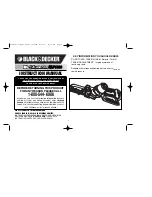
Page 1
DFS-100 ReefKeeper™ Saw
User Guide
Thank you for buying this Inland product. The DFS-100 ReefKeeper saw is designed for fragging corals. You will
fi
nd it works well with
both large polyp and small polyp stony corals, zooanthids, mushrooms, soft corals and live rock too. You will
fi
nd that the blade tends to
slice through soft tissue rather than crushing it like scissors, nippers, and shears, thus aiding in the recovery process. Please read all the
instructions for set up and use of your DFS-100.
Safety
•
It is extremely important to wear proper eye protection and rubber gloves
as some corals, especially zooanthids, are toxic! We
highly recommend that you wear safety goggles rather than safety glasses.
•
DO NOT wear loose clothing or any accessories (long necklaces, bracelets, shirts with long fringes, and similar) that might get caught
by the saw during operation.
•
Use only in a properly grounded and tested outlet. Under NO circumstances should you override the grounding system or modify the plug.
•
Set up your machine on a sturdy, level work surface that is water tolerant and at a comfortable height.
Parts and Assembly
Check to make sure that you have all the parts listed before beginning assembly. Assembly will take about 5 minutes and only requires a
Phillips screwdriver. Use the exploded drawing on the following page to reference parts and their placement during the assembly process.
Installing the Blade
When setting the saw up the
fi
rst time, follow the instructions as outlined below. If you are changing a blade you must
fi
rst remove the
table and BladeSert™ before continuing on.
1. Open the front cover. Position the diamond blade around the lower wheel and into
the right and left guide channels with the diamond surface facing the saw front. DO
NOT bend or twist the blade at any time during installation or use.
2. Use one hand to grasp the bottom of the upper wheel between two spokes and
gently pull the bottom of the wheel towards you (approximately 3/8
″
- you should
feel it move easily initially and then “hit” and not want to go further without
forcing), then pull the wheel down enough to place the blade around the upper
wheel using your other hand.
3. Slowly release the wheel, making sure the blade remains on both wheels and passes
through the right and left channels.
4. Tracking, the position of the blade on the wheels, is controlled by adjusting the tilt
of the upper wheel. Check the tracking by rotating the lower drive wheel several
revolutions by hand while watching the position of the blade on the wheels. The
blade should remain centered on both wheels. If the blade isn’t centered or comes off either wheel, you will need to adjust the
tracking and alignment as outlined in the next section. If the blade rides centered on the wheels skip to Installing the Work Table.
Adjusting Blade Tracking and Alignment
The wheels are factory aligned so that the position of the blade is controlled by adjusting the upper wheel tilt. On the back of the upper
housing is the tension device with a nylon tilt adjustment screw in the middle. Be aware that any changes made to the blade position on the
upper wheel will have the opposite effect on the blade’s position on the lower wheel. Read through the possible problems below to
fi
nd the
one that best describes what is happening when you hand turned the wheel and follow the instructions for
fi
xing it. Make all adjustments
in small increments.
Part No. Part Name
Qty. Color
Part No. Part Name
Qty. Color
90007
DiamondCut™ Blade
1
silver
65809114
Coolant Reservoir
1
gray
65829173 10-24 x 1/2
″
Nylon Screw
4
white
65809118
Coolant Reservoir Cover
1
gray
90033
Molded Work Table
1
black
65829184 Band Saw Coolant Tubing
1
clear
90022 BladeSert™
2
black
90016 Blade
Drip
Guide
1
gray
78824055 5/64
″
Long Arm Allen Wrench
1
black
65829114
10-24 3/4
″
Nylon Thumb Screw
3
white
90014
Leather Blade Wiper
1
brown
65829119
Band Saw Drain Hose
1
clear






















